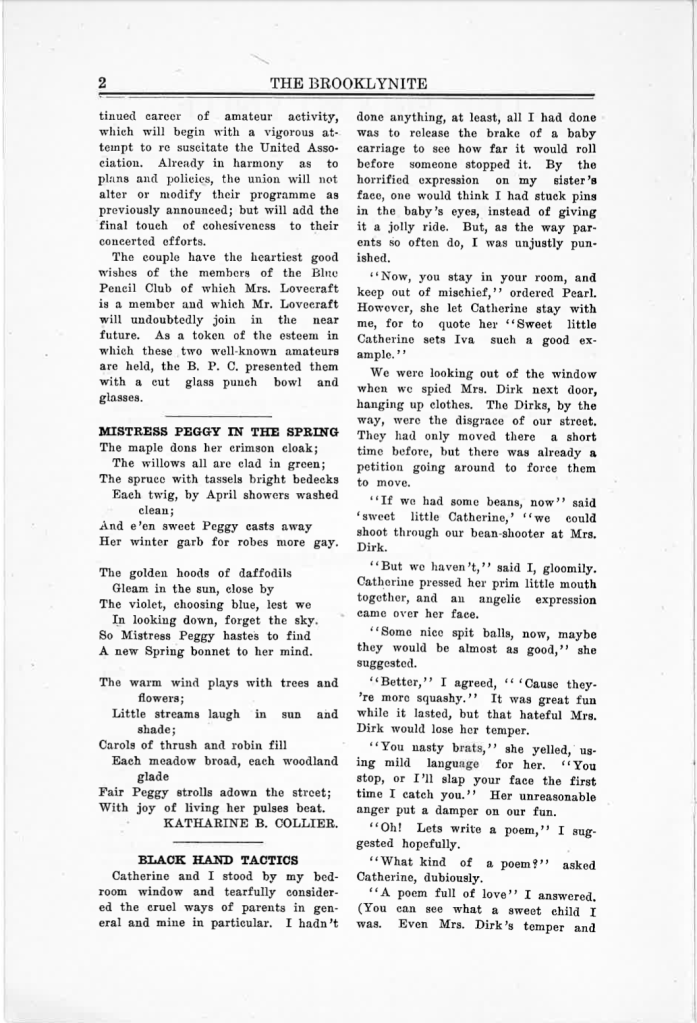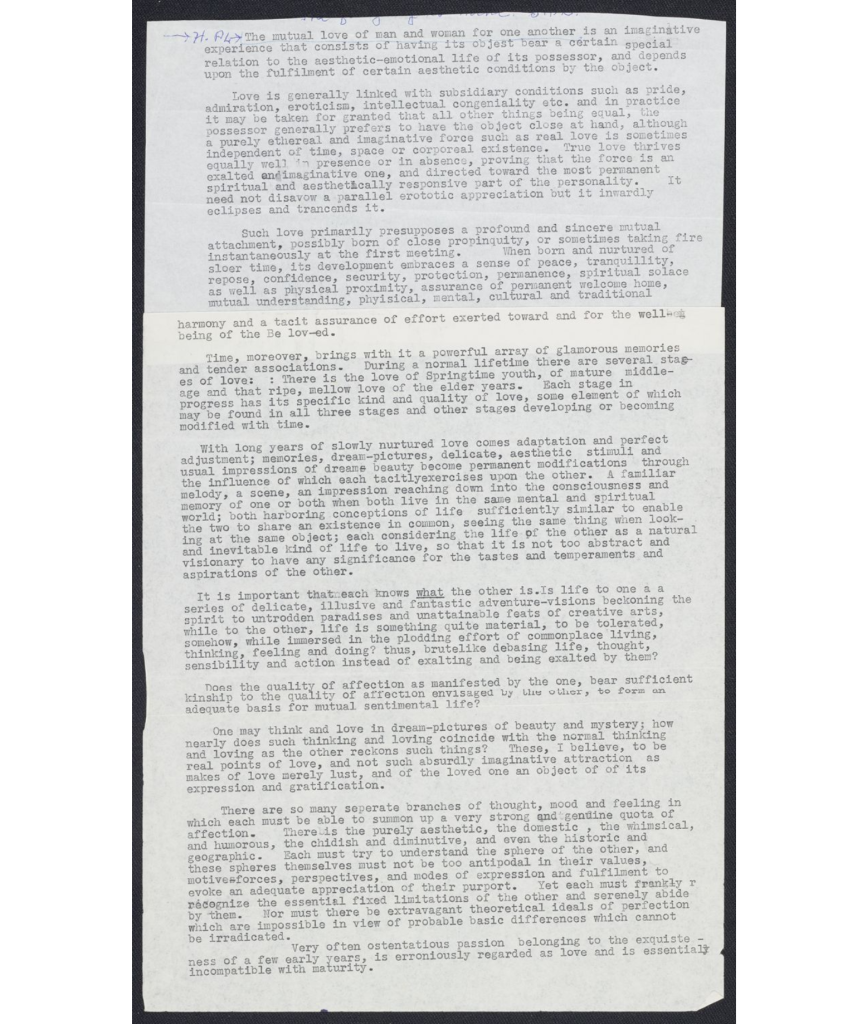Two are one. Another bears the name of Lovecraft. A new household is founded!
H.P. Lovecraft to Lillian D. Clark, March 9, 1924, Letters to Family and Family Friends 1.106.
Anything addressed to “H.P. Lovecraft” or (miraculous and unpredictable appellation) “Mrs. H.P. Lovecraft” will henceforward reach its recipient without additional formalities.
H.P. Lovecraft to Lillian D. Clark, March 9, 1924, Letters to Family and Family Friends 1.106.


A hundred years ago…
Before the altar and vast windows of St. Paul’s Chapel, Sonia H. Greene met the gaze of her soon-to-be husband. He, with the stamp of antiquarian appreciation, went through his stately assurance. Then, Reverend George Benson Cox, in traditional vestments and with a ceremonial expression, turned to Sonia. Would she take the weird writer in her midst, to be her husband, to have and to hold from that day forward, for better, for worse, for richer, for poorer, in sickness and in health, to love and to cherish, from that day forward till death would they part? The world stilled—the empty and solemn mood of the chapel deepened as though an audience waited with bated breath for her momentous decision. In the iridescent glow of the cross, whose delicate light adorned her with additional grace, Sonia said, “I do”.
On March 3, 1924, Howard Phillips Lovecraft and Sonia Haft Greene became husband and wife. Two became one: Mr. and Mrs. Lovecraft. They had stepped out of St. Paul’s Chapel with the high hopes of a lasting matrimonial bond, and with her own quiet hopes of making him a better man.
I had hoped (perhaps it was wish-thinking) that my ‘embrace’ would make of him not only a great genius but also a lover and husband.
Sonia H. Davis, The Private Life of Howard Phillips Lovecraft, unedited manuscript.
A hundred years later…
We look at that special day through scholarly lens, and perhaps even wish we had been witnesses to such a ceremony—sitting in one of the many empty rows, observing when they exchanged vows and rings. Yet, I believe that if we had been, at most, passersby on that day, striding past the open chapel doors, the scene within would’ve appeared as any ordinary ceremony taking place, and we might have overlooked its significance. It is only through the perspective of our present that we look back longingly to the past.
Fortunately, Howard and Sonia’s friends did not overlook the magnitude of such a day. The Blue Pencil Club, an amateur journalism organization of which Sonia was a member, announced the big news in their column “Blue Pencil Club Elects New Officers”, in The Standard Union:

Transcription:
Announcement was made of the recent marriage of one of the club’s members, Mrs. Sonia Greene, of 259 Parkside avenue, [sic] to Howard P. Lovecraft, of Providence, R.I.
In her memoir, Sonia revealed that the Blue Pencil Club had additionally elaborated on their wedding day:
An account of that marriage is to be found in the “BROOKLYNITE” April 1924 the official organ of the Blue Pencil Club of Brooklyn, N.Y.
Sonia H. Davis, The Private Life of Howard Phillips Lovecraft, unedited manuscript.


It is interesting to note that despite his kindness in having dedicated a poem to the newlyweds, Rheinhart Kleiner had reservations regarding their marriage. In “A Memoir of Lovecraft”, he recalled having felt “faintness at the pit of my stomach and became very pale” upon hearing the news from George Julian Houtain and his wife. Houtain, having laughed at the effect that the announcement had on Kleiner, “agreed that he felt as I did”. (Something About Cats, p. 221) While Kleiner does go on to praise Sonia for her outward beauty, he divulges further in his memoir that her “severe conduct” and naivety was something that gave a general feeling to others that Howard and Sonia were ill-fated as a pair.
Unfortunately, there isn’t enough accounts on Sonia from unbiased sources to give a clearer picture of Sonia’s true conduct. And I say “unbiased” only because the claims we have of Sonia are mainly from the close friends of Howard. They regarded him highly, and while outwardly beautiful, Sonia didn’t seem to measure up to the majority of them. Did her background as a Ukrainian Jewish woman have an impact on how they viewed her physically and intellectually? Most definitely.
While I can easily launch into the psychological reasoning behind Sonia’s overall behavior (which I did to some extent in the introduction to Two Hearts That Beat as One), what genuinely mattered most is what Howard saw in her. It speaks volumes of a man, who was devoutly xenophobic, to marry out of his preferred ethnic group. Why? Because we see that she was more than just an immigrant and a Jewess to him. He saw her the way she wanted to be seen: intellectually attractive. The truth is, what they shared most in common was intellectual thought and ideals—something that has not been entirely acknowledged.
In the provided account, The Brooklynite had claimed that “Mr. and Mrs. Lovecraft entertained members of the Blue Pencil Club at their home” on March 23, 1924. Howard had mentioned a possible meeting with fellow amateurs to his aunt, Lillian D. Clark:
We have now sent invitations to several amateurs to come over next Sunday…
H.P. Lovecraft to Lillian D. Clark, March 18, 1924, Letters to Family and Family Friends 1.115.
March 18th was a Tuesday, and March 23rd would have been that following Sunday, just days after Howard’s letter. In his subsequent letter to Lillian, he briefly referred to the meeting:
Yes—the assemblage of March 23 came off successfully…
H.P. Lovecraft to Lillian D. Clark, March 30, 1924, Letters to Family and Family Friends 1.130.
However, this “assemblage” was not in fact the Blue Pencil Club because only a few sentences down from that very same passage, he explained what happened:
On Saturday S.H. and I were to have gone to the Blue Pencil meeting; but on account of fatigue and a cold on her part we refrained. The next morning we rather regretted our absence, for it seems that the meeting had been something of a party in our honour, with a carefully prepared speech by Mortonius, and the presentation of a wedding gift—a magnificent set of glassware—by the club as a whole!
H.P. Lovecraft to Lillian D. Clark, March 30, 1924, Letters to Family and Family Friends 1.130.
The “magnificent set of glassware” is obviously the “cut glass punch bowl and glasses” that the Blue Pencil Club presented to them. Evidently, Mr. and Mrs. Lovecraft had not actually entertained the club, ultimately having missed a party in their honor. Nevertheless, it was obviously the thought that counted.
The fact that both Sonia and Howard were thoroughly immersed in amateur journalism, and especially because Sonia was by this point the president of the United Amateur Press Association, an identical report of their wedding was printed in the United Amateur.
On March 3, 1924, occurred the wedding of Sonia H. Greene, President of the United Amateur Press Association, and H.P. Lovecraft, Official Editor of that society.
The marriage is the culmination of nearly three years of acquaintance, beginning at the Boston convention of the National in 1921, and ripened by a marked community of tastes and parallelism of interests. It may quite justly be added to the long list of amateur journalistic romances which our social chroniclers delight to enumerate and extol.
The ceremony, performed by the Reverend George Benson Cox, took place at historic St. Paul’s Chapel, New York; a noble colonial structure built in 1766 and dignified by the worship of such elder figures as General Washington, Lord Howe, and that Prince of Wales who later became successively the Prince Regent and King George the Fourth.
Following the wedding, the bride and groom departed on a brief tour of the Philadelphia region, whose venerable and historical landmarks accorded well with the scene of the ceremony itself. On Sunday, March 23, after their return to New York, Mr. and Mrs. Lovecraft entertained members of the Blue Pencil Club at their home, 259 Parkside Avenue, Brooklyn, where, needless to say, amateurs will always be welcome.
Mr. and Mrs. Lovecraft plan a continued career of amateur activity, which will begin with a vigorous attempt to resuscitate the United. Already in harmony as to plans and policies, the union will not alter or modify their programme as previously announced; but will add the final touch of cohesiveness to their concerted efforts.
“News Notes”, United Amateur 23, No. 1, May 1924, Collected Essays, Volume 1: Amateur Journalism, 1.352-53.
Prior to Howard, Sonia had been married to Samuel Greene. After their divorce, Sonia dated Francis Bosco, a bank teller for Bank of Italy (later Bank of America). According to her autobiography, Francis and Sonia were engaged, but the engagement was called off because he was Catholic and she was Jewish. After Francis, Sonia revealed she fell hard for “Kay”, a gentleman she met at a ball. He was very much like Samuel Greene, smart and yet argumentative. All these men were book smart, but also abusive toward Sonia, except for Francis. He seemed to have treated her kindly.
By the time she met Howard, Sonia was depraved of the kind of love that went beyond “free love”. While Howard isn’t perhaps the sort of man one imagines as a “knight in shining armor”, he was just that for Sonia. She genuinely believed he was the man of her dreams:

Transcription:
After having met many men , [sic] some proposing marriage, a few indigent ones seeing in me a good “meal ticket” sought me for that, but not one as far as I could see, wanted me because there was anything in common between us, because there might have been real love; with several it seemed to me, it would have been a marriage of convenience; others bluntly suggested “Free love”, while a few probably did love me but I still sought the “man of my dreams”. One day I thought I had met him.
At some point during their lengthy correspondence, Howard and Sonia talked about love, and what made love genuine in a relationship. Sadly, since their correspondence did not survive, we don’t know the entirety of what said between the two regarding this particular topic. However, Sonia managed to preserve the passage that ultimately made her fall in love with him. This excerpt was later included in what would be the essay, The Psychic Phenomenon of Love.

At the back of the essay, she wrote:

Aside from his perception of love, Sonia also likely fell in love with the comforting prospect that Howard would respect her more, physically and emotionally, than her previous lovers. She knew he would not abuse her, but encourage her, not only entice her body, but seduce her mind. Yes, Howard had his flaws, but in comparison, he was precisely who she needed at that time of her life.
While the marriage ultimately failed, I will not focus on that unfortunate fact today, for today was a day in which both Howard and Sonia believed their love was eternal and worth the risk. Today, an exact century ago, they declared with clear certainty to be together for better, for worse, for richer, for poorer, in sickness, and in health. And when you really think about their relationship in the context of those marital assurances, their love had indeed persevered.
Sources:
Interior images of St. Paul’s Chapel: The New York Public Library Digital Collections.
The Brooklynite: The Katharine Brownell Collier Papers, 1895-1977 (Folder 5.12).
Songs behind the post:
Presentiments – Ilya Beshevli
when the party’s over – Billie Eilish


